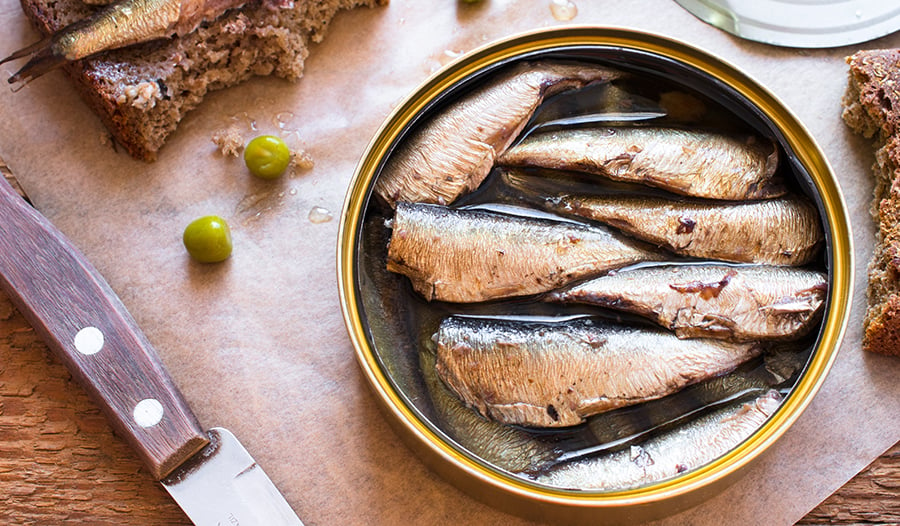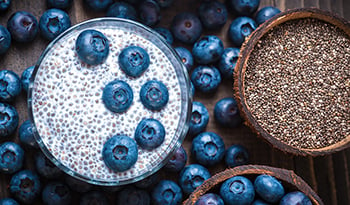A Dietitian's Tinned Fish Guide: Benefits, Nutrients, Recipes, and More
DISCLAIMER:This blog does not intend to provide diagnosis...
- In this article:
- Oil Vs. Water
- Omega-3s
- Protein
- Vitamins and Minerals
- Recipes With Tinned Fish
- Bottom Line

Looking for ways to incorporate more fish into your diet? Tinned fish is perhaps the easiest and most convenient option. Sardines, salmon, tuna, mackerel, and crab meat are some of the fish varieties you’ll find tinned, all of which are fully cooked and ready to incorporate into your favorite meals and snacks. Not only is tinned fish an easy way to add valuable nutrients to your meals, it also lends itself to a wide variety of preparations.
Through this article, you will learn the nutritional value of tinned fish—spoiler, it’s packed with essential nutrients!—and easy ways to use it in meals and snacks. Of course, tinned fish can be enjoyed on its own, but if you’re looking for recipe inspiration, keep reading.
Oil Vs. Water
Most varieties of tinned fish come in at least two options: packed in water or oil. There is no right or wrong here. Rather, it comes down to your flavor preference and energy needs. Options packed in water likely contain fewer calories. This is great for individuals monitoring their calorie intake or who prefer to spend their fat budget on other foods.
When preparing your tinned fish packed in water, you can use the water in your recipe or drain off as much water as you like before combining the fish with other ingredients. Draining the water will likely result in some lost nutrients, but many of the important nutrients are present in the fish itself.
Tinned fish packed in oil is popular because it adds another flavor layer to the fish, creating an especially delicious product. The oil also helps your body absorb more nutrients from the fish. Because oil is calorie-dense, fish packed in oil tends to be higher in calories than fish packed in water. However, the fat from the oil can also increase the satiety of your meal, helping you feel fuller.
Some of the nutrients found in fish, like vitamin D, are better absorbed by your body when fat is present, too. While some fish options, like salmon, contain higher amounts of fat, other options, like tuna, naturally contain very little fat. Choosing a tinned fish packed in oil can enhance nutrient absorption and add to the flavor profile, no matter the leanness of the fish. If you are concerned about the added calories from the oil, you can always drain off some to make the fish work better with your energy needs.
Omega-3s
Omega-3s are nutrients most unique to fish. Omega-3s are types of fat found in many varieties of fish as well as some plant-based foods, like nuts and seeds. Omega-3s are known for their heart health benefits and ability to reduce inflammation. They are also a source of essential EPA and DHA nutrients that play significant roles in brain development and function, as well as eye health.
While fish contains concentrated amounts of highly-bioavailable omega-3s, supplements are a good source of omega-3s for those who do not consume enough of this essential nutrient through food.
Protein
Tinned fish is also a great meal component because of its high protein content. Protein is an essential nutrient that must be consumed through the diet. Animal-based foods, like meat, fish, cheese, yogurt, and eggs, are some of the most naturally concentrated protein sources. You can also find protein in plant-based foods, like dried edamame, nuts, seeds, and nut butter, as well as protein bars and protein powders.
With so many ways to consume protein, there is no shortage of this nutrient in the American diet. However, tinned fish may be one of the most convenient natural protein sources. While meat and eggs take time to prepare and generally aren’t convenient when you need a meal on the go, you can add tinned fish to your bag as you head out the door.
Like fat, protein is a very satiating nutrient. Eating protein can help you feel fuller after meals and snacks, helping to offset overeating throughout the day.
Protein also plays many important roles in your body, including tissue maintenance, repair, and growth. Protein is especially known for its role in building muscle tissue. Additionally, protein aids in fluid balance in your body and helps maintain a proper pH. It also helps regulate your immune system.
Because protein is important for so many functions, your body always finds a way to make it available. For example, when you don’t consume enough dietary protein, your body breaks down protein-containing tissue to free up protein and amino acids for essential functions. With tinned fish, you have a convenient and easy source of healthy protein to ensure you are meeting your body’s needs.
Vitamins and Minerals
Tinned fish also provides a wide range of micronutrients, including vitamin D, B12, iron, and iodine. Additionally, eating the soft, tiny bones of fish like sardines provides calcium, an important nutrient for bone health. While micronutrients do not provide any calories, they are crucial for your body’s health. With functions in blood and bone health, energy metabolism, gene expression, and so much more, a diet rich in a variety of vitamins and minerals is essential for overall well-being.
Recipes With Tinned Fish
Tinned fish is incredibly versatile and can be used in an endless number of recipes. While you can enjoy tinned fish straight from the package and serve over whole grain crackers for a “lunchable” style meal or in romaine lettuce “boats” for a lower carb option, combining your fish with a few simple ingredients makes for a more well-rounded meal option. Here are a few ideas for how to enjoy your tinned fish.
Tinned Fish Salad
Instead of a lettuce-based salad, tinned fish is the star of the show in this recipe. I tend to use tuna or salmon when making these “salads,” but you could break up sardines or use crab meat just as easily.
Your salad will need a binder to keep everything mixed together. Mayonnaise is classically used in tuna salad and adds amazing flavor and creaminess. You could also swap the mayo for mashed avocado. Both options incorporate fat into the meal while serving as a binder.
Next, add some crunch. Finely chopped celery, bell pepper, and carrots work great. This adds nice texture throughout the salad along with vitamins, minerals, and antioxidants.
Lastly, boost the flavor. Your options here depend on your preferences, but some of my go-to ingredients are pickle relish or finely chopped pickles, dill, and mustard. Each of these packs an amazing punch of flavor for very few calories.
Once your salad is prepared, there are tons of ways to serve it—over crackers, in lettuce boats, over a large leaf salad, in cucumber boats, as a sandwich with whole grain bread, or packed into half of an avocado are some of my favorites.
Savory Fish Cake
Sorry, this isn’t the sweet birthday cake you may have envisioned, but rather a savory protein-packed option for when you need a quick dinner. Again, use any flaked or mashed tinned fish for this recipe.
Let’s start with the binder. Whisk two eggs with a healthy squeeze of lemon juice in a bowl, then add about ½ cup of breadcrumbs (seasoned or plain) and two to three tablespoons of cheese (grated parmesan and asiago add great flavor!). Next, add about five ounces of tinned fish and season with salt and pepper to your liking.
Heat a thin layer of avocado oil in a pan over medium heat. While the oil is heating, form your fish mixture into patties. Gently place each patty in the heated oil and cook for about five minutes on each side. Once cooked, let the patties rest on a paper towel to absorb some oil and serve with your favorite accompaniments. Enjoy as a burger with a whole grain bun and toppings, serve over a large veggie salad for a low-carb meal, or enjoy the patty on its own with a few side dishes.
Keep It Easy
In addition to serving your tinned fish with crackers or lettuce boats, these other low-prep serving options and quick, delicious ways to enjoy tinned fish!
- Serve atop avocado toast
- Place on a charcuterie board to be enjoyed with bread or crackers
- Fold into your favorite pasta dish
Bottom Line
Tinned fish is a quick and convenient way to add more fish to your diet. Rich in protein, healthy fats, and other important vitamins and minerals, there is no right or wrong way to enjoy tinned fish. Try some of these recipes, or simply enjoy tinned fish straight out of the package for a satiating and oh-so-healthy snack!
References:
- Djuricic I, Calder PC. Beneficial Outcomes of Omega-6 and Omega-3 Polyunsaturated Fatty Acids on Human Health: An Update for 2021. Nutrients. 2021;13(7):2421. Published 2021 Jul 15. doi:10.3390/nu13072421
- Calcium | National Institutes of Health Office of Dietary Supplements. https://ods.od.nih.gov/factsheets/Calcium-HealthProfessional/

 By Melissa Rifkin, MS, RDN, CDN
By Melissa Rifkin, MS, RDN, CDN


